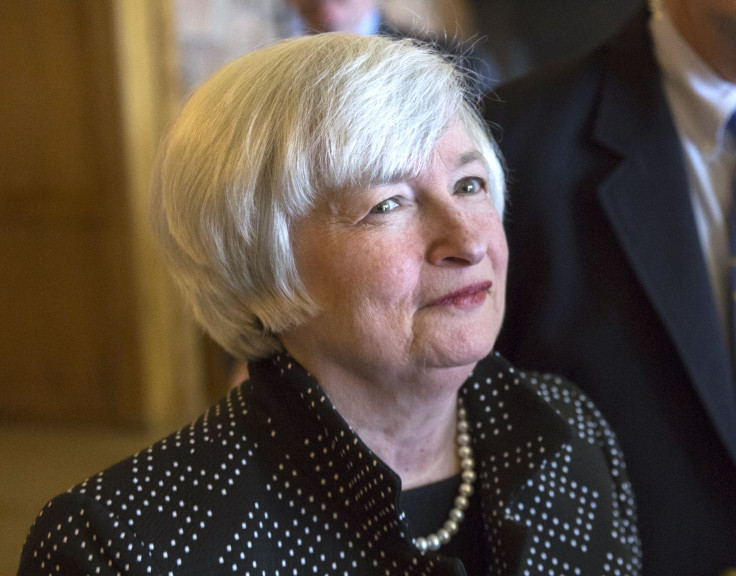Janet Yellen Policy Speech: Fed Chair Remains Focused On Job Creation But Rate Hikes Getting Closer

Fed Chair Janet Yellen on Friday laid out a vision of U.S. central bank policy that remains firmly focused on the labor market and continues to favor finding jobs on Main Street over telegraphing a precise message to Wall Street about interest rates. Economists were split about how accurately and clearly she laid out that position.
“It's an academic speech that gives no new clues or revelation about how they'll act,” Peter Boockvar, chief market analyst at Lindsey Group, told CNBC on Friday.
While the Fed’s release of minutes this week from a July meeting indicated the Fed was a little closer to raising interest rates, five key takeaways from Yellen’s speech indicated the Fed is not so keen on picking up the pace.
"Janet Yellen is telling the world that the most highly publicized indicator of the economy has shown steady and considerable improvement from the worst part of the recession, but the Fed is not yet seeing enough inflation so that it feels higher interest rates," Gary Burtless, senior fellow at Brookings Institution and former economist for the Labor Department, said on Friday. “Workers haven’t been getting their proportionate share of their productivity. It’s been going to the bottom line, to stock. "
IHS Global Insight analysts took a similar tack to Boockvar's, saying, “Yellen’s speech was the quintessence of the ‘two-handed’ economist, who takes pains to present both sides of an argument while avoiding taking a stand. This leads us to believe that the speech wasn’t intended to send a hawkish signal about the evolving stance of monetary policy, but to lay the groundwork for the issues that are to be discussed during the conference.”
Capital Economics’ senior U.S. economist Paul Dales said Yellen clearly remains more concerned about the threat of killing off a labor market rebound than about prices rising too fast. “Despite the faster-than-expected decline in the unemployment rate, Yellen does not appear to have changed her view that there is still 'significant' slack in the labor market,” he said on Friday.
“She repeated the old arguments about a cyclical decline in the participation rate, the high share of part-time workers and low rates of job turnover. She also noted that low wage growth points ‘to weaker labor market conditions than would be indicated by the current unemployment rate,’” Dales said.
But Brookings' Burtless conceded that, “There are a lot of signals about labor market slack. In spite of the employment rate, nonetheless, the economy and labor market isn’t really all the much stronger than a year ago. After all, we haven’t had outstanding growth in the U.S. We haven’t gone through any period where more than 300,000 jobs have been added."
Dales disagrees with the Yellen view of the labor market; he suggested that anecdotal data shows a more robust job market than Yellen sees. “The increasing proportion of firms saying that jobs are hard to fill and the growing share of households saying they are plentiful suggests that labor market slack is dwindling. Yes, wage growth has yet to pick up. But the surveys suggest that could happen later this year.”
Dales suggested that if wages do begin to catch up more quickly with job growth in coming months, the Fed will have to rush to raise rates.
Raising rates too quickly could backfire, weakening the job market as money to expand and create jobs becomes more expensive.
“In fact,” Dales said, “if the Fed waits until wage and price inflation rise significantly, it could find itself behind the curve, meaning that rates would have to rise further and faster than would otherwise have been the case.”
Others expressed concern that Yellen’s discussion of rising wages may indicate an earlier-than-expected rate hike. “Personally I’m a little concerned about that,” said Mark Mascia, president and CEO of New York-based real estate investment firm Mascia Development.
Firms like Mascia’s are particularly sensitive to rising rates. Real estate firms also play an important part in job growth as the economy improves, by providing work as firms expand and build new facilities and family balance sheets improve and spur residential market growth.
The Fed has certainly faced difficult decisions in the past. Two positive factors, rising employment and steady, if slower-than-previous economic growth following the Great Recession, are forcing the central bank to focus on eventual moves it’ll need to make.
But at this point, Burtless concluded, "Janet Yellen is telling the world that the most highly publicized indicator of the economy has shown steady and considerable improvement from the worst part of the recession, but the Fed is not yet seeing enough inflation so that it feels higher interest rates are needed."
© Copyright IBTimes 2025. All rights reserved.






















